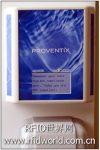
RFID hand wash stations help hospitals reduce the rate of patient medical infections
[ad_1]
According to the Princeton Baptist Medical Center in Alabama, USA, since the hospital adopted an RFID handwashing monitoring system in February 2010, the hospital’s time to accept patients with medical infection (HCAI) has been reduced by 36%. This is equivalent to a 125-day reduction in the length of hospitalization for patients who were infected by pathogens when they were hospitalized for treatment. This nGage system was provided by Proventix, and Synapse Technologies provided and installed special readers and tags. The operating frequency of readers and tags is 2.4 GHz and adopts the IEEE 802.15.4 (ZigBee) standard.
According to statistics from the World Health Organization (WHO), 5%-15% of hospitalized patients in developing countries are infected with pathogens while receiving treatment and have to extend their stay in hospital. This data prompted Proventix to develop this hand hygiene program with the goal of encouraging medical staff to follow good hand washing habits without interfering with their daily behavior. The company started developing this system three years ago. In November 2009, Proventix CEO Harvey Nix and the hospital management began to formulate a plan to implement this hand hygiene program on a certain floor of the hospital.
“We almost agreed to adopt this system without thinking about it,” said Paula Davenport, director of surgical services at Princeton Baptist Medical Center. “Because we all know that hand washing is the main way to prevent infection.” Since installing this system, she said, “We did find that the infection rate has decreased.”

Each nGage sink includes a screen to display information
In the past few years, some companies have introduced RFID hand washing systems. Some systems issue alarms via pagers or telephones, and some generate audible alarms to notify medical staff who have failed to wash their hands as required. However, Princeton Baptist wants to adopt a system that is easier and more comfortable for employees to use, rather than having a punitive impact on employees (for example, audible alarms will embarrass them). Although Proventix also sends alerts via pagers or telephones, Davenport stated that the hospital just wants to encourage employees to wash their hands, rather than sound a warning when they fail to follow suit.
Proventix installs a screen above the soap or alcohol dispenser on each washbasin in the hospital. Users can view the information displayed on the screen when they wash their hands. The washbasin is also equipped with an RFID reader. Although the medical center initially only displays common sense information on the screen, such as the effect of handwashing and the impact on diseases, in the future, Proventix software will display personalized information for handwashing users on the screen, such as providing patient medical information in the ward where the handwashing station is located. Moreover, the screen can also display CNN headlines or sports event news as required. In addition, if the doctor is visiting the patient in the ward, he or she can see the patient test or other medical residents while washing their hands to help them judge the next treatment.
Proventix installed an RFID hand washing station in each room on the post-operative floor of the hospital. There are a total of 42 hospital beds on this floor and a total of 80 hand washing stations on the entire floor. Each employee wears a 3.5-inch long plastic badge with an active RFID tag whose ID code corresponds to the individual’s name, position and other information in the Proventix independent software system. The mesh network formed by the reader allows RFID tags to be read and positioned on this layer. The tag sends a signal containing its ID code. Nix claims that the reader receives the signal and sends the tag ID code and its ID code to a network bridge, which is connected to the back-end system via Ethernet. Three network bridges are currently used on this floor.

nGage system uses RFID to record hand washing records of medical staff
When medical staff enter a patient’s room, the system judges that the hospital enters the room according to the ID code of the dispenser reader. When approaching the sink, they must press the dispenser button to use disinfectant or soap and water. At the same time, the software associates the ID code of the individual in front of the sink with the activity of the dispenser. The software then displays the user’s specific information, records and stores the event, and instructs the medical staff when and where to wash their hands.
When the medical staff leave the patient room, the system waits for the next hand washing event of the dispenser. If the doctor does use the dispenser a second time, the system records the event. If not, the system also generates a record indicating the event. Although this record will not be used to punish employees, Davenport said, “but we hope to encourage employees to wash their hands.” The system will generate employee handwashing records, display the number of personal handwashing on the screen, and compare it with other workers. “The medical industry itself is very competitive,” Davenport said.
There are hundreds of employees wearing badges, Davenport reports, in addition to their existing non-RFID ID credentials. In the future, Davenport hopes to integrate Proventix RFID tags directly into employees’ existing ID documents. In the next 6 weeks, the hospital plans to install this system in the nursing department, and after 6 months, it will be used throughout the hospital.
Davenport said that the hospital ultimately hopes to use the RFID infrastructure to track the location of assets by using the same RFID tags on the equipment.
[ad_2]



